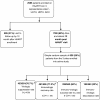Immuno-virologic outcomes and immuno-virologic discordance among adults alive and on anti-retroviral therapy at 12 months in Nigeria
- PMID: 23452915
- PMCID: PMC3599241
- DOI: 10.1186/1471-2334-13-113
Immuno-virologic outcomes and immuno-virologic discordance among adults alive and on anti-retroviral therapy at 12 months in Nigeria
Abstract
Background: Predictors of immuno-virologic outcomes and discordance and their associations with clinical, demographic, socio-economic and behavioral risk factors are not well described in Nigeria since HIV viral load testing is not routinely offered in public HIV treatment programs.
Methods: The HACART study was a multi-center observational clinic-based cohort study of 2585 adults who started HAART between April 2008 and February 2009. A total of 628 patients were randomly selected at 12 months for immuno-virologic analyses.
Results: Virologic suppression rate (<400 copies/ml) was 76.7%, immunologic recovery rate (CD4 change from baseline ≥50 cells/mm3) was 77.4% and immuno-virologic discordance rate was 33%. In multivariate logistic regression, virologic failure was associated with age <30 years (OR 1.79; 95% CI: 1.17-2.67, p=0.03), anemia (Hemoglobin < 10 g/dl) (OR 1.71; 95% CI: 1.22-2.61, p=0.03), poor adherence (OR 3.82; 95% CI: 2.17-5.97, p=0.001), and post-secondary education (OR 0.60; 95% CI: 0.30-0.86, p=0.02). Immunologic failure was associated with male gender (OR 1.46; 95% CI: 1.04-2.45, p=0.04), and age <30 years (OR 1.50; 95% CI: 1.11-2.39, p=0.03). Virologic failure with immunologic success (VL-/CD4+) was associated with anemia (OR 1.80; 95% CI: 1.13-2.88, p=0.03), poor adherence (OR 3.90; 95% CI: 1.92-8.24, p=0.001), and post-secondary education (OR 0.40; 95% CI: 0.22-0.68, p=0.005).
Conclusions: Although favorable immuno-virologic outcomes could be achieved in this large ART program, immuno-virologic discordance was observed in a third of the patients. Focusing on intensified treatment preparation and adherence, young patients, males, persons with low educational status and most importantly baseline anemia assessment and management may help address predictors of poor immuno-virologic outcomes, and improve overall HIV program impact. Viral load testing in addition to the CD4 testing should be considered to identify, characterize and address negative immuno-virologic outcomes and discordance.
Figures
References
-
- Kitkungvan D. Secure antiretroviral therapy delivery in a resource-limited setting: streamlined to minimize drug resistance and expense. HIV Med. 2008. - PubMed
-
- Kamoto K, Aberle-Grasse J. Surveillance of transmitted HIV drug resistance with the World Health Organization threshold survey method in Lilongwe, Malawi. Antivir Ther. 2008;13(Suppl 2):83–7. - PubMed
Publication types
MeSH terms
Substances
Grants and funding
LinkOut - more resources
Full Text Sources
Other Literature Sources
Medical
Research Materials
Miscellaneous


